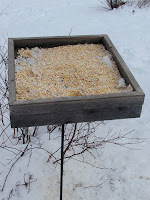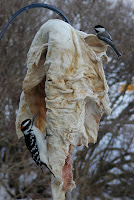
Feeding fruit in the winter will attract a whole different group of birds than the seed feeders. Apples are probably the easiest and cheapest, seconds and “deer apples” are available from local growers at a very reasonable price. Birds tend to like them after they've been frozen for a while, like the ones that have been hanging in the branch all winter. If you have a fruit tree in your yard it's a good idea tramp the snow down and throw diced apples on the ground under the tree. They will be eating dropped fruit anyway and this just keeps the source from running out, most fruit eaters are described “vagrant species” and will stay with you as long as there is food, when it’s gone, so are they. You can also feed fruit on a raised platform, in a suet cage right in the tree or even in a bird bath that’s not being used. I’ve had birds come to suction cup mounted feeders on the window for fruit.
Fruit eating birds like Robins, Waxwings, Orioles and Mockingbirds will also come for globe grapes, bananas, cranberries and parboiled raisins if you can afford it. You can also plant mountain ash, high-bush cranberry, hawthorn, sumac and grapes. It’s a good idea to harvest some of this fruit and freeze it for feeding later in the winter, especially grapes as the raccoons will strip the vine before hibernation.
Providing shelter is always a good way to increase traffic to your feeders and even more so in winter. Birds like shelter from the cold prevailing winds and from predators, a totally open landscape is not too likely to attract many visitors on a cold windy day, a temporary fix is to stick some trees in the snow, tie them to a post or even the feeder pole itself. Old Christmas trees are great, before our trees got big enough to provide cover, I would pick up trees that were with the roadside garbage and give them a few more months of usefulness, birds love the shelter from wind and from cruising hawks.
A brush pile is a great way to attract birds, I like to start with a half sheet of plywood to make a lean to, open to the South. The coldest Northerly winds will be deflected up and over the opening, and the sun will shine in the South facing opening warming the area. Then I cover the whole thing with branches, I try to gather interesting drift wood and other branches so it’s a bit more appealing to the eye. I like to feed millet right inside the pile, even though you can’t always see the sparrows and junco eating, you’ll see them coming and going and when they perch on the highest branches of the pile to survey territory. By placing the branches close enough together you can exclude pigeons from the feed inside. If you put a platform feeder in the middle of the pile, you’ll be able to keep more seed out and it will stay fresher.
Platform feeders are popular with a very wide range of birds and they can accommodate large flocks at one time, even the smaller finch that you normally think of as using small tube feeders will crowd onto a platform feeder, that is until a larger bird comes along. Commercially available platform feeders are made of plastic or perforated metal, but they can be simply a piece of wood with a ridge nailed around the outside to keep the seed from blowing off. A better design is a frame with wire mesh on the bottom for drainage, then they are either placed on top of a post or mounted on 4 legs, coffee table style. I used to think bigger was better when I made my platform feeders, now I favour smaller sizes. First, if it’s small enough you won’t need a support board across the middle that will end up catching droppings and seed dust; and if it’s smaller the birds tend to sit on the edge more, where their droppings land on the ground rather than on the seed.
Covered platforms seem like a great idea, but they are less likely to be used by birds than the simple open platform, I assume it’s because they can’t see oncoming predators. The higher the roof, the more the birds seem to like it, but with the high roof, more snow and rain blows in. After a snowfall, especially of the crusty topped Maritime variety, the covered platforms may be the only feeders open for business, then they do get more action, but the birds seem wary to spend too much time under the roof. I like to keep at least one covered platform in use for those mornings I don’t drag myself out before dawn.
 A little advice on making your own platform feeder: make 2 identical square frames out of about 1 x 1 ½ inch stock, staple hardware cloth (¼ or ½ inch) to one frame then window screen to the other. Sandwich the 2 together and mount with the screen facing up (use screws to make replacing the screen easier). The hardware cloth offers more support for the screen but, most importantly...if a squirrel happens along a snow covered platform, he doesn’t shovel the snow off, he chews a hole in the screen and eats his way into the feeder under the snow, where he is hidden from predators and is likely quite warm in his little improvised igloo. Then you come along quite unaware of the little furry bandit and use your arm to shove the snow off the chest high platform feeder. Let’s just say that it startles you more than a little when a squirrel pops out of the pile of snow in the crook of your elbow, bounds up your arm, launches himself off your shoulder and into the tree. Then to add to the insult, when you look up from your flat-on-the-back position under the feeder, the squirrel is on an overhanging branch scolding you. So I repeat, hardware cloth is a good idea on the bottom.
A little advice on making your own platform feeder: make 2 identical square frames out of about 1 x 1 ½ inch stock, staple hardware cloth (¼ or ½ inch) to one frame then window screen to the other. Sandwich the 2 together and mount with the screen facing up (use screws to make replacing the screen easier). The hardware cloth offers more support for the screen but, most importantly...if a squirrel happens along a snow covered platform, he doesn’t shovel the snow off, he chews a hole in the screen and eats his way into the feeder under the snow, where he is hidden from predators and is likely quite warm in his little improvised igloo. Then you come along quite unaware of the little furry bandit and use your arm to shove the snow off the chest high platform feeder. Let’s just say that it startles you more than a little when a squirrel pops out of the pile of snow in the crook of your elbow, bounds up your arm, launches himself off your shoulder and into the tree. Then to add to the insult, when you look up from your flat-on-the-back position under the feeder, the squirrel is on an overhanging branch scolding you. So I repeat, hardware cloth is a good idea on the bottom.
written by Dwayne Biggar at The Bird Garden








